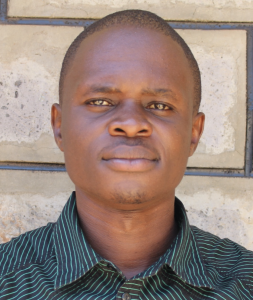April, 2024: Nangurunya Community Spring Protection Complete!
Nangurunya Community now has access to clean water! Thanks to your donation, we transformed their spring into a flowing source of naturally filtered water. We also installed a chlorine dispenser to provide added protection and trained the community on improved sanitation and hygiene practices. Together, these components will unlock the opportunity for community members to live better, healthier lives.

Happy for clean water!
"Clean, safe water is a basic human need. No one person should be deprived of it. For many years now, typhoid, diarrhea, and sore throat complications have been a menace in this community. My household has fallen victim [to] the infections numerous times, draining our finances. Protection of the spring guarantees us access to clean water, keeping our health safe," said Simon Indwale.

Simon at the protected spring.
"Accessibility to the spring has been eased, allowing all age groups [to] access the water point at any given time of need. [The] installation of stairs has allowed for easy accessibility. Before [the] protection of the spring, members used to get injured in the course of water collection. To access the spring, one had to maneuver through the gradual slope, and this was a challenge whenever it rained as it was steep. Installation of additional stairs has helped solve the challenge," Simon continued.
"Development in a community comes about when the members live a healthy life. Clean, safe water is one of the components that promote a healthy life. Access to clean, safe water will positively impact members' lives encouraging growth. Living a healthy life will allow me [to] put much focus on developing myself financially. When financially stable, I will be able to consider [a] good education for my children and grandchildren. [With their] health not being compromised, my children and grandchildren will be able to have time for class and also to play," concluded Simon.
Children were just as excited as adults about the new water point.
"Our household hygiene standards will improve. My mother used to spend a lot of time fetching water when we were at school, compromising house chores. She will now be able to do her house chores more frequently, like cleaning the house, clothes, and utensils, due to [the] availability of water. She will also be able to have ample time to tend to her farm, that has been her source of income," said 12-year-old Salome.

Salome.
Preparing for Spring Protection
Community members worked together to source and carry all locally available construction materials to the spring. These included bricks, sand, stones, and fencing poles. Some people also chiseled away at large rocks to break them into gravel. Because people have to carry most items by hand, the material-collection process can take anywhere from a few weeks to months.
When the community was ready, we sent a truck to deliver the remaining construction materials, including cement, plastic tarps, and hardware. Then, our construction artisan and field officers deployed to the spring to begin work. Individual households provided meals throughout each day to sustain the work team.
From Open Source to Protected Spring: A Step-by-Step Process
First, we cleared and excavated the spring area. Next, we dug a drainage channel below the spring and several runoff diversion channels above and around the spring. These help to divert surface contaminants away.
To ensure community members could still access water throughout the construction process, we also dug temporary channels around the construction site from the spring's eye. This allowed water to flow without disrupting community members' tasks or the construction work. Excavation created space for setting the spring's foundation, made of thick plastic, wire mesh, concrete, and waterproof cement.

Beginning the brickwork.
After establishing the base, we started brickwork to build the headwall, wing walls, and stairs. Once the walls had grown tall enough, we began one of the most crucial steps: setting the discharge pipe. The discharge pipe needs to be positioned low enough in the headwall so the water level never rises above the spring's eye, yet high enough to allow room for the average jerrycan (a 20-liter container) to sit beneath the pipe without making contact, which prevents cross-contamination.
If we place the discharge pipe too high above the spring's eye, back pressure could force water to emerge elsewhere. Too low, and community members would not be able to access the water easily. We embedded the pipe using clay (or mortar when the clay is in short supply) and placed it at an incline to ensure water flows in the right direction.

Setting the discharge pipe.
In coordination with brickwork, we pitched stones on both sides of the spring's drainage channel. We then cemented and plastered each stone, forming the rub walls. These walls discourage people and animals from standing in that area, which could cause soil erosion and a clogged drainage area.
We then cemented and plastered both sides of the headwall and wing walls. These finishing layers reinforce the brickwork and prevent water in the reservoir from seeping through the walls. In turn, enough pressure builds in the reservoir box to push water out through the discharge pipe.

Plastering.
As the headwall and wing walls cured, we cemented and plastered the stairs and installed four tiles beneath the discharge pipe. The tiles protect the concrete from the falling water's erosive force while beautifying the spring and facilitating easy cleaning of the spring floor.
The final stage of construction is backfilling the reservoir box behind the discharge pipe. We cleared the collection box of any debris that may have fallen during construction. Then, we redirected the temporary diversion channels back into the reservoir box, channeling water into this area for the first time. We close all other exits to force water through only the discharge pipe.

Backfilling the reservoir box.
We filled the reservoir area with the large, clean stones community members had gathered, arranging them in layers like a well-fitting puzzle. We covered the rocks with thick plastic to minimize potential contamination sources, then piled enough dirt on top to compensate for future settling.
Community members transplanted grass onto the backfilled soil to help prevent erosion. The collection area was fenced to discourage any person or animal from walking on it. Compaction can lead to disturbances in the backfill layers and potentially compromise water quality.

Community members planted grass and helped build the fence.
The construction process took about two weeks of work and patience to allow the cement and plaster to finish curing. As soon as the spring was ready, people got the okay from their local field officers to fetch water.
We officially handed over the spring to mark the community's ownership of the water point. Happiness, thanksgiving, and appreciation were the order of the day, flowing in all directions.

Celebrating clean water.
Training on Health, Hygiene, and More
Together with the community, we found their preferred date for training while considering other community calendar events, such as the agricultural season and social events. We requested a representative group of community members to attend training and relay the information learned to the rest of their families and friends.
When the day arrived, facilitators Amos, Mitchell, and Dorcas deployed to the site to lead the event. Seventeen people attended the training, including nine women and eight men.

The soapmaking session.
We covered several topics, including community participation in the project; leadership and governance; personal, dental, and environmental hygiene; water handling and treatment; spring maintenance; the importance of primary health care and disease prevention; family planning; soapmaking; how to make and use handwashing stations; and the ten steps of handwashing.

Training.
During the leadership and governance session, we held an election for the newly formed water user committee leaders, who will oversee the maintenance of the spring. We also brainstormed income-generating activities. Community members can now start a group savings account for any future minor repairs to the spring and a cooperative lending group, enabling them to develop small businesses.
A favorite session was the ten proper steps of handwashing.

Learning proper handwashing techniques.
"Simon, a participant in the training, felt that the steps took too long and that by the time one completes the steps, food will have gotten cold. This raised a debate amongst the participants, with some backing Simon while others in disagreement with his opinion. The facilitator explained to the participants that clean hands were a determinant of one's health and that if ignored, one was likely to compromise his or her health. It was unanimously agreed that the ten steps were critical and should be adopted to promote healthy living," said Field Officer Rachael Obura.

Simon.
"The training has been enriching. We have gathered a lot of information that relates to hygiene and sanitation standards. We have been reminded that health standards dictate the level of growth and development in a community. As a community, we are still lagging behind when it comes to development. Adoption of all the positive information we have gathered in the training will allow us [to] improve ourselves and the entire community. We promise to disseminate all we have learned to members who never managed to attend the training," said Simon Mmula, chairman of the water user committee (mentioned above).
Conclusion
This project required a substantial collaboration between our staff, our in-country teams, and the community members. When an issue arises concerning the spring, the water user committee is equipped with the necessary skills to rectify the problem and ensure the water point works appropriately and there is guaranteed public access in the future. However, if the issue is beyond their capabilities, they can contact their local field officers to assist them.
Also, we will continue to offer them unmatchable support as a part of our monitoring and maintenance program. We walk with each community, problem-solving together when they face challenges with functionality, seasonality, or water quality. Together, all these components help us strive for enduring access to reliable, clean, and safe water for this community.
With your contribution, one more piece has been added to a large puzzle of water projects. In Kenya, Uganda, and Sierra Leone, we're working toward complete coverage. That means reliable, maintained water sources within a 30-minute round trip for each community, household, school, and health center. With this in mind, search through our upcoming projects to see which community you can help next!
Thank you for making all of this possible!









 Protected Spring
Protected Spring
 Rehabilitation Project
Rehabilitation Project

































